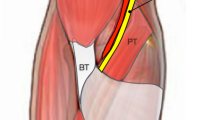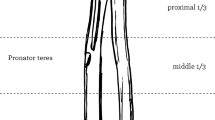Abstract
Background
While the majority of terrible triad elbow injuries (ulnohumeral dislocation with radial head and coronoid fractures) are managed surgically, nonoperative treatment may be appropriate in selected patients, but results with this approach have been limited by very small studies.
Questions/purposes
We assessed (1) functional outcomes using two validated questionnaires, (2) elbow ROM, strength, and stability, (3) the presence of union and arthritis on radiographs, and (4) complications among a group of patients managed nonoperatively for terrible triad injuries.
Methods
Between 2006 and 2012, we retrospectively identified 12 patients with terrible triad elbow injuries who were treated nonoperatively and met the following criteria: (1) a concentric joint reduction, (2) a radial head fracture that did not cause a mechanical block to rotation, (3) a smaller coronoid fracture (Regan-Morrey Type 1 or 2), and (4) a stable arc of motion to a minimum of 30° of extension to allow active motion within the first 10 days. Eleven patients were available for followup of at least 12 months after the injury (mean, 36 months; range, 12–90 months). Outcome measures included two patient-reported functional outcome measures (DASH, Mayo Elbow Performance Index [MEPI]), a standardized physical examination to record elbow ROM and stability, isometric strength measurements, and radiographic evidence of bony union and elbow arthrosis. Complications were also recorded.
Results
At latest followup, mean ± SD DASH score was 8.0 ± 11.0 and mean MEPI score was 94 ± 9. Mean ROM of the affected elbow was 134° ± 5° flexion, 6° ± 8° extension, 87° ± 4° pronation, and 82° ± 10° supination. No instability was detected. Strength assessments demonstrated the following mean percentages of the contralateral, unaffected elbow: flexion 100%, extension 89%, pronation 79%, and supination 89%. Four patients had arthritic changes on radiographs that did not call for treatment as of latest followup. Complications included one patient who underwent surgical stabilization for early recurrent instability and another who underwent arthroscopic débridement for heterotopic bone.
Conclusions
In selected patients, nonoperative treatment of terrible triad injuries is an option that can provide good function and restore stable elbow ROM. However, nonoperative management requires close clinical and radiographic followup to monitor for any delayed elbow subluxation or fracture displacement.
Level of Evidence
Level IV, therapeutic study. See Instructions for Authors for a complete description of levels of evidence.



Similar content being viewed by others
References
Armstrong AD, MacDermid JC, Chinchalkar S, Stevens RS, King GJ. Reliability of range-of-motion measurement in the elbow and forearm. J Shoulder Elbow Surg. 1998;7:573–580.
Broberg MA, Morrey BF. Results of treatment of fracture-dislocations of the elbow. Clin Orthop Relat Res. 1987;216:109–119.
Chemama B, Bonnevialle N, Peter O, Mansat P, Bonnevialle P. Terrible triad injury of the elbow: how to improve outcomes? Orthop Traumatol Surg Res. 2010;96:147–154.
Closkey RF, Goode JR, Kirschenbaum D, Cody RP. The role of the coronoid process in elbow stability: a biomechanical analysis of axial loading. J Bone Joint Surg Am. 2000;82:1749–1753.
Doornberg JN, van Duijn J, Ring D. Coronoid fracture height in terrible-triad injuries. J Hand Surg Am. 2006;31:794–797.
Guitton TG, Ring D. Nonsurgically treated terrible triad injuries of the elbow: report of four cases. J Hand Surg Am. 2010;35:464–467.
Lindenhovius A, Karanicolas PJ, Bhandari M, Ring D. Radiographic arthrosis after elbow trauma: interobserver reliability. J Hand Surg Am. 2012;37:755–759.
Longo UG, Franceschi F, Loppini M, Maffulli N, Denaro V. Rating systems for evaluation of the elbow. Br Med Bull. 2008;87:131–161.
Mason ML. Some observations on fractures of the head of the radius with a review of one hundred cases. Br J Surg. 1954;42:123–132.
Mathew PK, Athwal GS, King GJ. Terrible triad injury of the elbow: current concepts. J Am Acad Orthop Surg. 2009;17:137–151.
O’Driscoll SW, Bell DF, Morrey BF. Posterolateral rotatory instability of the elbow. J Bone Joint Surg Am. 1991;73:440–446.
Pipicelli JG, Chinchalkar SJ, Grewal R, Athwal GS. Rehabilitation considerations in the management of terrible triad injury to the elbow. Tech Hand Up Extrem Surg. 2011;15:198–208.
Pugh DM, Wild LM, Schemitsch EH, King GJ, McKee MD. Standard surgical protocol to treat elbow dislocations with radial head and coronoid fractures. J Bone Joint Surg Am. 2004;86:1122–1130.
Regan W, Lapner PC. Prospective evaluation of two diagnostic apprehension signs for posterolateral instability of the elbow. J Shoulder Elbow Surg. 2006;15:344–346.
Regan W, Morrey B. Fractures of the coronoid process of the ulna. J Bone Joint Surg Am. 1989;71:1348–1354.
Ring D, Jupiter JB, Zilberfarb J. Posterior dislocation of the elbow with fractures of the radial head and coronoid. J Bone Joint Surg Am. 2002;84:547–551.
Rodriguez-Martin J, Pretell-Mazzini J, Andres-Esteban EM, Larrainzar-Garijo R. Outcomes after terrible triads of the elbow treated with the current surgical protocols: a review. Int Orthop. 2011;35:851–860.
Schneeberger AG, Sadowski MM, Jacob HA. Coronoid process and radial head as posterolateral rotatory stabilizers of the elbow. J Bone Joint Surg Am. 2004;86:975–982.
Acknowledgments
The authors thank Ms. Kate Kelly MSc, MPH for her training in the use of equipment required for measurement of outcomes in this study.
Author information
Authors and Affiliations
Corresponding author
Additional information
Each author certifies that he or she, or a member of his or her immediate family, has no funding or commercial associations (eg, consultancies, stock ownership, equity interest, patent/licensing arrangements, etc) that might pose a conflict of interest in connection with the submitted article.
All ICMJE Conflict of Interest Forms for authors and Clinical Orthopaedics and Related Research ® editors and board members are on file with the publication and can be viewed on request.
Each author certifies that his or her institution approved the human protocol for this investigation, that all investigations were conducted in conformity with ethical principles of research, and that informed consent for participation in the study was obtained.
This work was performed at University of Western Ontario, London, Ontario, Canada.
About this article
Cite this article
Chan, K., MacDermid, J.C., Faber, K.J. et al. Can We Treat Select Terrible Triad Injuries Nonoperatively?. Clin Orthop Relat Res 472, 2092–2099 (2014). https://doi.org/10.1007/s11999-014-3518-9
Published:
Issue Date:
DOI: https://doi.org/10.1007/s11999-014-3518-9




